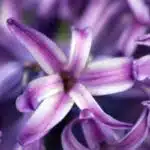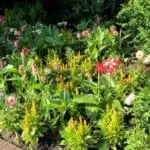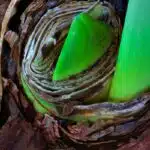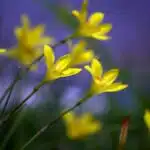Planting and caring for a hyacinth is an enjoyable experience that can bring beauty to any home. The heavenly hues of the blooms, along with the pleasant fragrance, make this bulb an easy choice when considering what to grow in your garden. Homeowners who want to harness the beauty and fragrance of hyacinths need to understand how to plant, grow, and care for these lovely flowers.
The perfect present for your garden can be found in planting a few hyacinth bulbs! With proper preparation and patience, you can soon have a wonderful array of colors gracing your outdoor space. Growing hyacinths is not difficult as long as you know the basics on how to plant, grow, and care for them.
Taking time to learn about how you can successfully plant, grow, and care for a hyacinth will help ensure that your efforts are rewarded with beautiful blooms each season. Keep reading to learn all the helpful hints needed so you too can enjoy the heavenly hues and fragrances of these delightful flowers in your own garden!
Choosing A Location For Growing Hyacinths
Where to plant hyacinths is an important factor in their success. While many gardeners may be drawn to their vibrant colors and heavenly scent, proper selection and preparation of a planting location is essential. So, let’s explore how to find the perfect spot for your hyacinths!
One great thing about hyacinths is that they don’t require too much light or heat; in fact, they thrive best in semi-shaded areas with indirect sunlight. That said, it’s important to make sure the area gets at least six hours of sun per day. Additionally, you’ll want to choose a cool site that won’t get too hot during the summer months; otherwise, the flowers may wilt and die prematurely.
When selecting a planting site for your hyacinths, you’ll also need to consider drainage and soil quality. Hyacinths don’t do well in wet or waterlogged conditions, so it’s important to choose an area that has good drainage; otherwise, the bulbs may rot before they have a chance to bloom. As for soil type, hyacinths prefer rich, loamy soil with plenty of organic matter; adding compost or other natural fertilizers can help improve both drainage and nutrition in the soil.
With careful consideration of these factors –light exposure, temperature regulation, drainage and soil quality– you can create an ideal environment for growing healthy and beautiful hyacinth plants!
Preparing The Soil For Planting
Once you’ve determined the ideal location to grow your hyacinths, it’s time to prepare the soil for planting. This is an important step in the process and can make a big difference in the success of your blooms.
To begin, it’s best to loosen the soil with a garden fork or tiller and then mix in some compost or other organic matter. Doing this allows air, water and nutrients to penetrate into the soil more easily and helps create a better environment for healthy root growth. Additionally, if your soil is clay-based, adding sand can help improve drainage so that water doesn’t stay too long around the roots of your hyacinths.
When planting hyacinths, be sure to follow any additional instructions provided on the package label about how deep to plant them. Generally speaking, most bulbs should be planted twice their height deep into the ground with pointed ends facing up. Once planted, cover with several inches of mulch or compost to help retain moisture and provide protection from fluctuations in temperature.
With your soil prepped and ready to go, all that’s left is obtaining your bulbs and getting them in the ground!
Obtaining The Bulbs And Planting
When it comes to bulbs, hyacinths are among the most popular. In fact, according to statistics from the American Horticultural Society, over 26 million hyacinth bulbs were sold in 2018 alone! So if you’re looking for a beautiful and fragrant flower to grow in your garden this season, hyacinths are a great option. Now let’s discuss how to obtain and plant these bulbs for the best results.
First off, you’ll want to source your hyacinth bulbs from a reliable supplier. You can find them at garden centers, nurseries, or online stores that specialize in flower bulbs. When selecting bulbs, look for ones that are firm and heavy with no signs of damage or decay. It’s also important not to buy over-sized bulbs as they won’t produce flowers as well as smaller varieties.
Once you have your bulbs on hand, you can start planting them right away. Ideally, you should plant the bulbs three times their height deep and about four inches apart from each other in well-draining soil that’s slightly acidic with a pH between 6 and 7.5. If you live in an area with cold winters, make sure to mulch around the plants once they’ve been planted to protect them from frost. With a bit of care and attention, your hyacinths will be ready to bloom in no time!
Watering And Fertilizing Hyacinths
Objection: It may be difficult to know how much water and fertilizer hyacinths need.
However, it’s actually quite straightforward. Watering and fertilizing hyacinth plants is an important step for ensuring that they thrive. With the right amount of attention, you can keep these flowers looking beautiful all season long.
First of all, water hyacinths regularly. Make sure to give them enough water so that the soil doesn’t dry out completely in between watering sessions. Additionally, use a balanced fertilizer during the growing season to give the plants some extra nutrition. This can help make sure that your hyacinths have everything they need to reach their full potential.
When fertilizing, it’s best to use something mild and slow-release like a liquid or granular fertilizer with nitrogen, phosphorus, and potassium. Apply the fertilizer according to directions on the package; too much will cause damage while too little won’t provide enough nourishment for your plants. With proper care and attention, your hyacinths will be blooming beautifully in no time!
Mulching is also beneficial for hyacinths since it helps retain moisture in the garden soil while preventing weeds from taking over.
Mulching The Soil In The Garden
Mulching the soil in the garden is an important part of hyacinth care. A layer of mulch will help keep the soil moist, prevent weeds from growing, and insulate the roots from extreme temperatures. It’s essential to make sure that the mulch is applied evenly across the entire bed. This will ensure that all of the hyacinth plants get an equal amount of moisture and protection.
When mulching, be careful not to cover up any emerging shoots or flowers. The mulch should be about 2-3 inches deep and spread out over a 6-inch radius around each plant. It’s best to use a natural material such as bark chips or compost for mulching hyacinths, as these materials are known to provide excellent drainage and insulation for the plants’ roots.
Once you’ve got your hyacinths set up with their protective layer of mulch, they’ll need plenty of regular watering and fertilizing in order to stay healthy and thrive throughout the growing season. With proper care and attention, your hyacinths will be a stunning addition to your garden all year round! Next up, let’s look at how we can control weeds and pests in our hyacinth beds.
Controlling Weeds And Pests
Weeding and pest control can be a daunting task for gardeners, particularly when it comes to hyacinths. These plants are beautiful, but they require special attention to keep them healthy. It’s like having a pet: you have to feed it, groom it, and ensure that there are no pests or weeds eating away at its leaves. To illustrate this point, consider the story of my friend’s garden – she had neglected her flowers for far too long and was dealing with an infestation of aphids on her hyacinths.
Fortunately, there are a few simple approaches for controlling weeds and pests in your garden. Firstly, keep an eye out for any signs of damage to the foliage or roots of the plants as these could indicate the presence of pests or disease. Secondly, use mulch around your plants to prevent weed growth and discourage pests from attacking them. And thirdly, if needed, apply a natural insecticide or fungicide to get rid of any unwanted visitors in your garden.
The best way to ensure that your hyacinths stay healthy is by practicing good maintenance habits such as regular pruning and deadheading. This will help reduce the need for chemical treatments while keeping the plants looking neat and attractive all season long. Pruning also helps improve air circulation among the leaves which can help prevent fungal diseases from developing while deadheading removes spent blooms which can reduce seed production thereby reducing future weed growth in the garden.
Pruning And Deadheading Hyacinth Plants
Pruning and deadheading hyacinth plants is an essential part of their upkeep. Not only does it keep them looking neat and tidy, but it also helps to promote healthy growth and prolong blooming. Pruning and deadheading can be done throughout the growing season to ensure the best results.
When pruning, you should cut back the stems once they’re done flowering, making sure to cut them at a 45-degree angle just above a set of healthy leaves. This will help promote new shoots from the base of the plant for more vibrant blooms next year. Deadheading involves removing spent flowers as soon as possible to prevent the formation of seed pods and encourage further blooming. You can easily do this by pinching off faded flowers at their base with your fingers or using pruners.
It’s also important to monitor your hyacinths for signs of disease or pests. If you spot any wilted or discolored foliage, remove it immediately to prevent further spread. Taking these steps will help your hyacinths stay healthy and looking beautiful in your garden all season long. And with that all taken care of, we move on to staking and supporting tall varieties for even greater success!
Staking And Supporting Tall Varieties
When you think of tall, graceful plants, hyacinths may come to mind. These beautiful flowers are a sight to behold in the garden and can be supported by staking. For those who want to get that perfect look for their hyacinths, staking is an important part of the process.
Staking is used to help keep plants upright when they are top-heavy, as hyacinths can be. This can help prevent them from flopping over and becoming misshapen or damaged, which could take away from the overall beauty of the plant. The stakes should be placed at least 1 foot away from the base of the plant so that it has room to grow and not be hindered by them. It’s also important to use stakes that are strong enough to support the weight of the plant without being too heavy for it.
To secure your hyacinths, tie them loosely with twine or other soft materials such as strips of cloth or fabric ties. Be sure not to tie too tightly or it could cause damage to the stem or flower buds. And if you’re using wooden stakes, make sure they have been treated so they don’t rot in wet weather conditions. With proper staking and tying, your hyacinths will remain upright and beautiful throughout the season without needing additional support.
Supporting your hyacinths with stakes is just one step in ensuring your plants stay healthy and vibrant throughout their growing season – next up is digging up and dividing bulbs for replanting in different locations around your garden!
Digging Up And Dividing Bulbs
Digging up and dividing bulbs is like solving a puzzle. It can be tricky to navigate, but with these easy steps you can get it done! Here are a few tips for digging up and dividing hyacinth bulbs:
• Wear gardening gloves when handling the bulbs – they can easily be damaged. • Use a garden fork or trowel to loosen the soil around the bulb before you try to remove it. • When removing the bulb, carefully lift it out of the ground without breaking it. • Separate larger clusters of bulbs into smaller clusters with two or three bulbs in each cluster. • Store excess bulbs in a cool, dry place until you are ready to replant them.
The process of digging up and dividing hyacinth bulbs may seem daunting at first, but once you’ve done it once or twice, it will become much easier! Plus, by taking this step now, you’ll ensure that your hyacinths have plenty of room to grow and bloom for many years to come. To make sure that your plants remain healthy and vibrant, however, it’s important to also take steps towards controlling disease in hyacinth plants.
Controlling Diseases In Hyacinth Plants
A bright and cheerful bloom, hyacinths are beloved by gardeners around the world. But while they bring joy to our gardens, they can be vulnerable to some diseases. Thankfully, there are ways you can control these diseases with a few simple steps.
Controlling diseases in hyacinth plants is easy with the right tools and knowledge. You’ll need to keep an eye out for signs of disease, like yellowing leaves or stunted growth. If you spot any of these signs, take action quickly by removing affected leaves and providing extra warmth and moisture to encourage healthy blooms. Additionally, make sure you’re fertilizing your plants regularly; this will give them the nutrients they need to stay strong and resistant to disease.
Finally, make sure you’re practicing good garden hygiene. Remove any debris from the soil around your hyacinths and avoid overcrowding them in one space. This will help prevent any spread of disease between plants.
TIP: Use a fungicide spray on your hyacinths on a regular basis as a preventative measure against diseases!
Drying And Storing Bulbs In The Off-Season
Taking a break from your hyacinths during the off-season might sound like a good idea, but there are some steps you can take to keep them in their best condition. Drying and storing bulbs in the off-season is essential for keeping them healthy and ready for planting when spring arrives. Here are some tips to consider:
• Give the bulbs a month of dormancy after they finish blooming. This will help reduce disease pressure and store energy. • Wait until the foliage turns yellow before removing it from the ground. • Place bulbs in a cool, dry spot with plenty of ventilation and no sunlight. • Inspect the bulbs periodically; discard any that are shriveled or discolored.
Once you’ve taken these steps, you’re ready to move on to planting your hyacinths in containers or directly into the ground when spring arrives! But first, it’s important to understand how different soil types affect hyacinth growth—soil that has too much moisture or not enough nutrients can be detrimental for your plants.
Planting Hyacinths In Containers
Planting hyacinths in containers is a great way to enjoy the beauty of these fragrant flowers. Start by finding a pot that’s at least 10 inches deep and 8-10 inches wide, with drainage holes. Fill it with well-draining soil and dig a small hole for the bulb. Place the bulb in the hole with its pointed end facing up and cover it with soil. Be sure to keep the top of the bulb at least 3 inches below the rim of the pot. Water thoroughly and place it where it will get plenty of sunlight, preferably near a window or outside on a sunny patio or deck.
When planting multiple bulbs, make sure you space them far enough apart so they won’t crowd each other when they bloom. Once planted, give your hyacinths three weeks of cold temperatures to encourage root growth before moving them indoors or into an area that’s protected from frosts and cold winds. If necessary, move them back outdoors in late spring when temperatures are above 55°F (13°C) during the day.
Once established, water your hyacinths regularly to keep their soil moist but not soggy. Feed your plants every two to four weeks during their blooming period with a balanced liquid fertilizer for best results. Deadhead any blooms that have faded away to encourage new ones to form and keep your plant looking its best throughout its growing season.
TIP: If you’re planting potted hyacinths indoors, be sure to rotate them halfway through their flowering period so all sides get equal exposure to light for even blooming!
Growing Hyacinths Indoors
If you’re looking to bring a bit of beauty and color into your home, growing hyacinths indoors is the way to go. These plants are known for their fragrant blooms in a variety of colors, so they can make any space look stunning. Plus, growing them indoors isn’t as hard as many people think – with just a few tips and tricks, you’ll be able to successfully cultivate your own indoor hyacinth garden.
The first step in growing hyacinths indoors is to choose an appropriate pot or container for the bulbs. Many people opt for clay pots that have drainage holes at the bottom – this will help keep the soil from getting too waterlogged. Additionally, it’s important to use a good quality potting soil that contains organic matter and will provide plenty of nutrients for the bulbs.
Next, it’s time to actually plant the bulbs. Place them at least two inches below the surface of the soil and make sure they are securely planted – then add enough soil over them until they are completely covered. After that, all you need to do is water your bulbs regularly and allow some sunlight in on occasion – with these simple steps, you should start seeing some beautiful blooms in no time!
With a little care and attention your indoor hyacinth garden can flourish and become an oasis of color within your home. You may even find yourself wanting to experiment with forcing bulbs for even more vibrant blooms – but we’ll cover that in another article soon!
Forcing Hyacinth Bulbs For Indoor Blooms
Gifting yourself and your loved ones with an indoor hyacinth bloom is one of the best presents you can give! Forcing a hyacinth bulb to bring out its vibrant colors indoors can be done easily with a few straightforward steps. Let’s take a look at how we can make this happen!
The first step in forcing a hyacinth bulb indoors is to select healthy bulbs that feel heavy for their size. Place the bulbs in pots filled with potting soil, then cover them with a thin layer of the same soil. Water the pots so that the soil is evenly moist.
Next up, store the potted bulbs in a cool location at temperatures between 45-55 degrees Fahrenheit. This could be anywhere like an unheated basement, crawl space, or garage. After 8-10 weeks, you’ll find that your hyacinths have bloomed inside!
Now that you’ve enjoyed these beautiful blooms indoors, it’s time to dispose of them properly to avoid them taking up too much space or attracting pests.
Disposing Of Hyacinths After Blooming
After enjoying the vibrant beauty of hyacinth blooms, it’s time to think about what comes next. In the same way we plan for planting and caring for our hyacinths, we need to be thoughtful about how to dispose of them once they’ve finished their flowering season. Here’s how to ensure your hyacinths are disposed of correctly, so that you can enjoy their bloom again next year.
First and foremost, don’t throw away your spent bulbs! Hyacinth bulbs can be replanted and reused if done correctly. Begin by cutting off the foliage just above the soil surface with a sharp pair of scissors or pruners. If there are any dead or damaged leaves on the plant, cut those off too. Don’t toss out the bulbs though – they still have life in them!
Once you’ve snipped off all the foliage, let the bulbs dry out completely before replanting them in a new spot in your garden or container. During this period of drying out, it’s important to keep an eye on any remaining foliage so that it doesn’t become infected with fungus or disease. If you notice any discoloration or wilting leaves, remove them immediately as this could spread to other nearby plants and damage them as well.
Finally, store used hyacinth bulbs in a cool, dry place until you’re ready to replant them. When planted properly and cared for appropriately, these bulbs will reward you again with a glorious display of blooms come next springtime!
Frequently Asked Questions
When Is The Best Time To Plant Hyacinths?
Planting is a time for promise, potential, and possibility. When it comes to planting hyacinths, timing is everything. Knowing when the best time to plant them is essential for ensuring that these beautiful blooms reach their full potential in the garden.
The trick to successful hyacinth planting is to plan ahead of the season. Planting them during autumn will give them a head start on blooming in springtime. To ensure good drainage, amend clay soil with compost or sand before planting. In addition, add fertilizer and mulch around the bulbs after they’re planted to improve drainage and discourage weeds.
For those who want an even earlier bloom, pre-chilling hyacinth bulbs indoors can be done 6-8 weeks before planting outdoors in late winter or early spring. Indoors, provide a warm spot (around 65°F) and keep the soil evenly moist but not soggy until the shoots emerge from the soil. Once planted outside, regular waterings are necessary for optimal growth and flowering; if too wet or too dry, the flowers won’t last as long as they should! With proper care and patience, your hyacinths will be sure to bring beauty and joy into your garden with their stunning colors and sweet scent.
How Often Should I Water My Hyacinths?
Watering your hyacinths is key to keeping them healthy and happy. But how often should you water them?
The answer depends on a few different factors, such as the climate where you live, the type of soil in your garden, and the season. In general, it’s best to check the soil around your hyacinths for moisture before watering. If the top inch of soil is dry, then it’s time to give the plants a good drink. This may be anywhere from once a week to every day depending on conditions.
It’s also important to make sure that you provide enough water for your hyacinths when you do water them. Aim for about an inch of water at each watering session – this will give the roots enough moisture without overwatering them. You can measure this by filling up a container or cup with water and placing it near your hyacinths while they are being watered.
By monitoring moisture levels and providing adequate amounts of water when needed, you can ensure that your hyacinths stay healthy and continue to bloom throughout the season. With proper care, you’ll be rewarded with beautiful blooms that will last all spring long!
How Long Do Hyacinths Typically Bloom For?
Many gardeners appreciate the beauty of hyacinths as one of the earliest flowers to bloom in spring. Not only are they eye-catching, but they also provide a delightful scent to the garden. But how long do these beautiful plants typically bloom for?
The average life of a flowering hyacinth is around two months, though this can vary depending on the climate and other factors. Generally, blooms will emerge in early spring and remain through late April or early May. In warmer climates, blooming may extend into June or July. Here are some things to take note of when caring for hyacinths:
• Water regularly and deeply – Be sure to water your hyacinths consistently and deeply so that the soil stays evenly moist. Avoid letting the soil dry out completely between waterings.
• Fertilize – Fertilizing your hyacinths during their growth cycle can help promote healthy blooms for longer periods of time. Use an all-purpose fertilizer at half strength every month or two throughout their growing season.
• Mulch – Applying a thin layer of mulch around your hyacinth plants can help retain moisture in the soil and protect them from extreme temperatures and weather conditions. Make sure to keep mulch away from direct contact with stems or leaves to avoid rot or fungal diseases.
• Monitor temperature – Hyacinths prefer cooler temperatures, so be mindful of where you plant them and ensure their temperature stays within optimal ranges for maximum blooming potential and longer lasting flowers.
To get the most out of your hyacinths it’s important to create an environment that promotes healthy growth and blooming capabilities. With regular care and maintenance, you’ll be able to enjoy these beautiful flowers for up to two months each year!
Are Hyacinths Toxic To Pets Or Children?
Are hyacinths toxic to pets or children? This is a valid concern, especially if you have curious children or pets in your home. Fortunately, hyacinths are not considered toxic. They’re actually quite safe for both kids and animals. However, there are a few things to consider when caring for them:
Firstly, the bulbs of the plant can be quite sharp if handled incorrectly – so it’s important to keep them away from children and pets. Secondly, as with any plant, if a pet or child were to ingest the leaves of a hyacinth then it could cause an upset stomach. Lastly, both cats and dogs may be tempted to chew on the leaves; however this isn’t recommended as it can damage them.
Luckily, these plants have many positive benefits that make them worth the effort! Hyacinths will bring beautiful color and fragrance into your home while also being low-maintenance – needing only minimal watering and pruning. Plus they’re non-toxic – so you don’t need to worry about any accidents happening due to curious kids or pets.
Caring for hyacinths is easy: just remember to keep their bulbs away from children and pets; refrain from letting them eat any part of the plant; water sparingly; and enjoy the beauty they bring!
Can Hyacinths Be Grown In Full Shade?
Hyacinths, with their vibrant colors and fragrant blooms, can bring life to any garden. But what do you do if your spot is too shady? Can hyacinths still be grown in full shade? The answer is yes!
Although they prefer a sunny area, these delicate flowers can still thrive in partial or even full shade. They will just need a little extra TLC. To get the most out of your plants, make sure to choose a spot that gets at least five hours of sunlight each day. This will help maintain the vibrant colors and keep them blooming longer.
To ensure success, provide your hyacinths with plenty of moisture and fertilizer throughout the growing season. Mulch can also help conserve moisture and keep weeds away from the roots. With proper care and attention, you’ll soon have beautiful hyacinths that gracefully dance across your garden – even on those darkest days!
Conclusion
Hyacinths are beautiful, fragrant flowers that can bring a lot of color and life to any garden. With the right care and attention, they can be very rewarding and will give you blooms for years to come. However, there are a few things that need to be taken into account when planting, growing, and caring for hyacinths. By understanding the best time to plant them, how often they need watering, how long they typically bloom for, if they are toxic to pets or children, as well as whether or not they can grow in full shade, you will be able to ensure your hyacinths stay healthy and vibrant.
The success of your hyacinth plants lies in the hands of the gardener; it is up to you to provide them with the necessary conditions for growth. With just a little bit of effort and knowledge you can have beautiful blooming hyacinths all season long. The sweet fragrance and colorful display that these plants offer is worth taking the time to learn about their needs so that you can enjoy them year after year.
So why wait? Get out there today and start planting your own hyacinths! With patience and proper care, soon you’ll have an abundant flower bed filled with breathtakingly beautiful blossoms that will fill your home with their sweet scent. Who knows—you might even find yourself getting hooked on gardening!





























